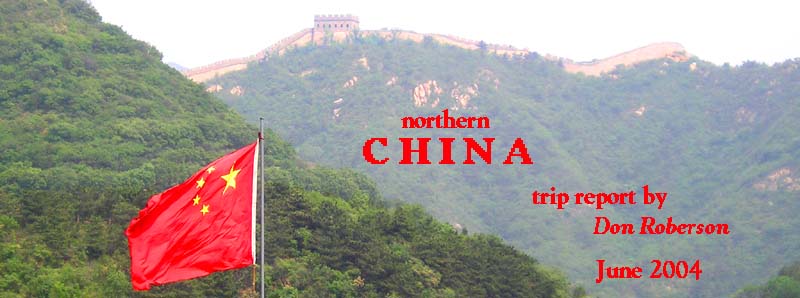

|
1) forested hills near Beijing, as well as ponds at the Summer Palace and other Beijing historic sites 2) grasslands and wetlands on the Manchurian plain in northeastern China, and 3) the Qinghai-Tibetan Plateau of Qinghai [pronounced "Ching-hi"] Province, including Qinghai Lake, the arid Caka Valley, and the Daban Shan Mts. The trip was remarkably successful in finding the prize birds of these regions, including 3 endangered cranes, good views of 3 pheasants plus a snowcock plus a grouse and 3 partridges, endemic ground-jay and groundpecker, ten redstarts, 6 snowfinch, 5 rosefinch, Lammergeier, and Great Bustard. It was also remarkably successful as my first foreign trip using digiscoping as my primary photographic method. The following gallery has just a few of the highlights: |
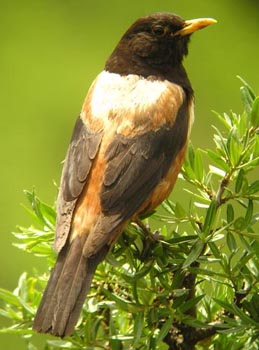 |
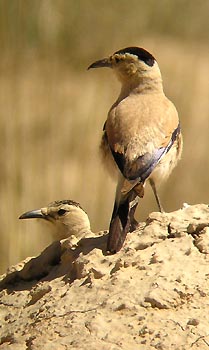 |
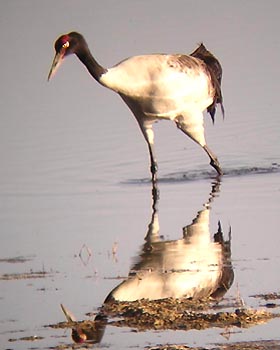 |
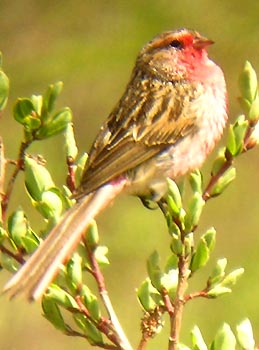 |
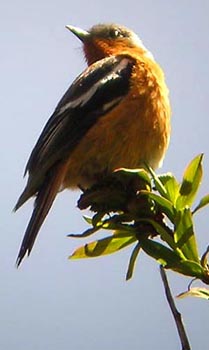 |
 |
|
Those on the bottom row have not often been photographed . |
Top row above (L to R):
|
Second row above (L to R):
|
Note: Pink-tailed (or Przevalski's) Bunting or Rosefinch Urocynchramus pylzowi has been problematic. It is often listed as a bunting (e.g., MacKinnon & Phillipps 2000) but our field impressions of behavior and song were that it was more like a rosefinch. Recent biochemical evidence (Groth 2000) supports the view that it is a neither a bunting nor rosefinch, but quite possibly in its own family [Urocynchramidae]. It differs from both buntings and finches in having 10 primaries, and appears to be a divergent basal lineage in the Passeroida.
 |
A trip to China had not been on my immediate agenda. But around Christmas 2003, Roger Wolfe loaned me Peter Matthiessen's The Bird of Heaven: Travels with Cranes, By the end of the book, China or Siberia had become a priority — I wanted to see some rare east Asian cranes! So the Chairman and I came to an arrangement: I'd visit him at Tiananmen Square (left) and his minions wouldn't arrest me.... China is not a place that one visits easily on your own. Very few Chinese speak English; arrangements are complicated; and foreigners cannot rent cars. So it would have to be a tour. |
 I
search the 'net and the brochures I had filed away for east Asian tours
that promised both cranes and pheasants. The choices tended be either one
or the other.. not both. But I came upon the Sunbird tour that did both,
plus the basic tourist spots: I
search the 'net and the brochures I had filed away for east Asian tours
that promised both cranes and pheasants. The choices tended be either one
or the other.. not both. But I came upon the Sunbird tour that did both,
plus the basic tourist spots:
|
 |
|
As to cranes, I've put together a separate web page: click below
|
||
|
||
|
||
|
The links below include many more photographs.
|
Beijing, Hebei, and Manhuria |
|
the Qinghai-Tibetan Plateau with Qinghai Lake & the Daban Shan Range |
|
for the 6-26 June 2004 TRIP covering birds & mammals & herps |
|
REDSTARTS OF NORTH CHINA photos & discussion of all 10 species |
PHOTOS: All photos on this page are © 2004 Don Roberson except the Blood Pheasant © 2004 David Fisher and used with permission; all rights reserved. Many other shots from this trip are scattered about this web site. Check particularly bird families, mammals, and herps listings.
Literature cited:
Groth, J.G. 2000. Molecular evidence for the systemaic position of Urocynchramus pylzowi. Auk 117: 787-791.TOPMacKinnon, J., and K. Phillipps. 2000. A Field Guide to the Birds of China. Oxford Univ. Press, Oxford.
Matthiessen, P. 2001. The Bird of Heaven: Travels with Cranes. North Point Press, New York.
Meyer de Schauensee, R. 1984. The Birds of China. Smithsonian Instit. Press, Washington, D.C.
GO TO LIST OF BIRD FAMILIES OF THE WORLD